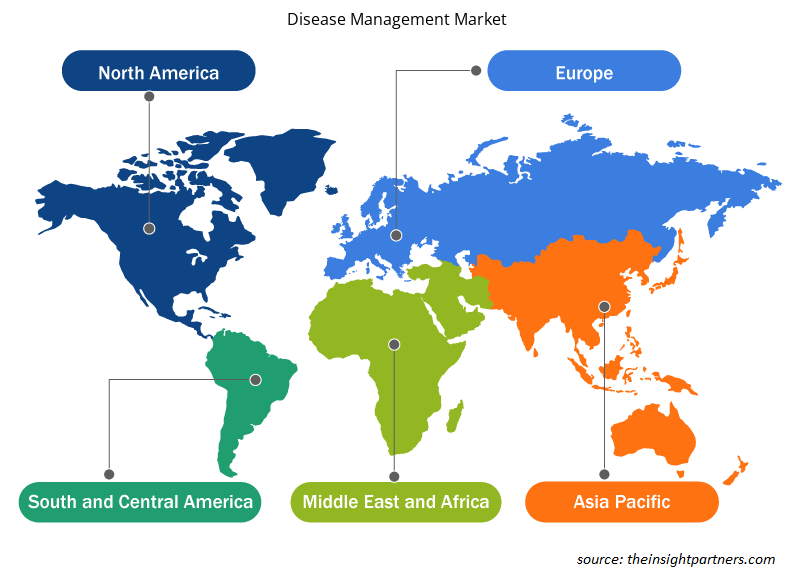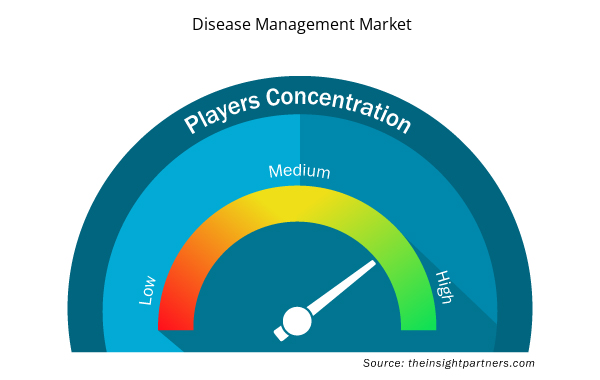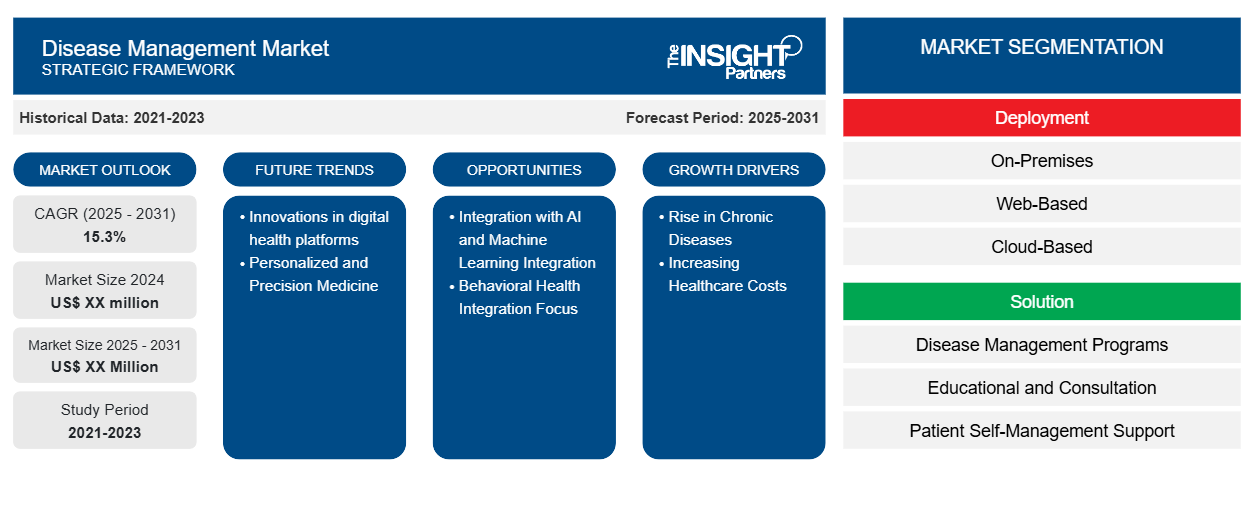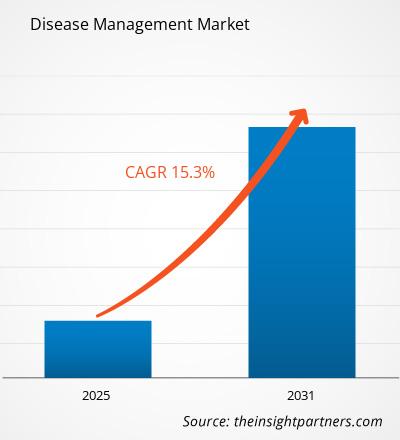Se espera que el mercado de gestión de enfermedades registre una CAGR del 15,3 % entre 2023 y 2031, con un tamaño de mercado que se expandirá de US$ XX millones en 2023 a US$ XX millones en 2031.CAGR of 15.3% from 2023 to 2031, with a market size expanding from US$ XX million in 2023 to US$ XX Million by 2031.
El informe está segmentado por implementación (local, basada en la web, basada en la nube); solución (programas de gestión de enfermedades (DMP), educación y consulta, apoyo a la autogestión del paciente, tecnologías de la información sanitaria (HIT), otros); indicación de enfermedades (enfermedades cardiovasculares, diabetes, cáncer, trastornos pulmonares obstructivos crónicos (EPOC), otros); usuarios finales (pagadores, proveedores, otros). El análisis global se desglosa aún más a nivel regional y por países principales. El informe ofrece el valor en USD para el análisis y los segmentos anteriores.
Propósito del Informe
El informe Disease Management Market de The Insight Partners tiene como objetivo describir el panorama actual y el crecimiento futuro, los principales factores impulsores, los desafíos y las oportunidades. Esto proporcionará información a diversas partes interesadas del negocio, como:
- Proveedores/fabricantes de tecnología: Para comprender la dinámica cambiante del mercado y conocer las oportunidades potenciales de crecimiento, lo que les permitirá tomar decisiones estratégicas informadas.
- Inversionistas: Realizar un análisis exhaustivo de tendencias sobre la tasa de crecimiento del mercado, las proyecciones financieras del mercado y las oportunidades que existen en toda la cadena de valor.
- Órganos reguladores: Regular las políticas y vigilar las actividades del mercado con el objetivo de minimizar los abusos, preservar la confianza de los inversores y defender la integridad y la estabilidad del mercado.
Segmentación del mercado de gestión de enfermedades
Despliegue
- En las instalaciones
- Basado en la web
- Basado en la nube
Solución
- Programas de manejo de enfermedades
- Educativo y Consulta
- Apoyo a la autogestión del paciente
- Tecnologías de información sanitaria
Enfermedades Indicación
- Enfermedades cardiovasculares
- Diabetes
- Cáncer
- Trastornos pulmonares obstructivos crónicos
Usuarios finales
- Pagadores
- Proveedores
- Otros
Usuarios finales
- Pagadores
- Proveedores
- Otros
Personalice este informe según sus necesidades
Obtendrá personalización en cualquier informe, sin cargo, incluidas partes de este informe o análisis a nivel de país, paquete de datos de Excel, así como también grandes ofertas y descuentos para empresas emergentes y universidades.
- Obtenga las principales tendencias clave del mercado de este informe.Esta muestra GRATUITA incluirá análisis de datos, desde tendencias del mercado hasta estimaciones y pronósticos.
Factores impulsores del crecimiento del mercado de gestión de enfermedades
- Aumento de las enfermedades crónicas: uno de los principales impulsores del mercado de la gestión de enfermedades es la creciente prevalencia de enfermedades crónicas en todo el mundo. Afecciones como la diabetes, la hipertensión, las enfermedades cardiovasculares y los trastornos respiratorios están en aumento debido a factores como el envejecimiento de la población, los estilos de vida poco saludables y los factores ambientales. El creciente número de personas con enfermedades crónicas ha generado una mayor demanda de soluciones de gestión de enfermedades que puedan mejorar la atención al paciente, reducir las hospitalizaciones y gestionar eficazmente las afecciones de salud a largo plazo.
- Aumento de los costes sanitarios: el aumento de los costes sanitarios es una de las principales preocupaciones de los gobiernos y los proveedores de servicios sanitarios de todo el mundo. Las enfermedades crónicas, en particular, suponen una importante carga financiera para los sistemas sanitarios debido a las necesidades de tratamiento a largo plazo, las hospitalizaciones frecuentes y la atención de urgencia. Los programas de gestión de enfermedades que hacen hincapié en la atención preventiva, la intervención temprana y el tratamiento a largo plazo de las enfermedades crónicas se consideran cada vez más una solución para reducir los costes sanitarios. Estos programas ayudan a minimizar las visitas al hospital, mejorar la adherencia de los pacientes a los planes de tratamiento y reducir los gastos generales de atención sanitaria.
Tendencias futuras del mercado de gestión de enfermedades
- Innovaciones en plataformas de salud digital: Las plataformas de salud digital se volverán cada vez más populares junto con nuevos análisis, monitoreo en tiempo real e interfaces más fáciles de usar. Es probable que las plataformas fomenten una mejor comunicación entre pacientes y proveedores de atención médica. Los modelos de gestión de enfermedades estarían centrados en el paciente y se considerarían sus preferencias y requisitos.
- Medicina personalizada y de precisión: A medida que el campo de la medicina continúa evolucionando, la medicina personalizada y de precisión se está convirtiendo en una tendencia clave en el manejo de enfermedades. Con los avances en la genómica y la identificación de biomarcadores, los proveedores de atención médica ahora pueden adaptar los planes de tratamiento a cada paciente en función de su composición genética, estilo de vida y características específicas de la enfermedad. Se espera que esta tendencia mejore la eficacia de los programas de manejo de enfermedades al orientar los tratamientos más adecuados para cada paciente, mejorando los resultados y minimizando los efectos secundarios.
Oportunidades de mercado en el manejo de enfermedades
- Integración con IA y Machine Learning Integración: Un beneficio del uso de inteligencia artificial y aprendizaje automático es la mejora de la estratificación de riesgos, el análisis predictivo y una mayor personalización en la planificación del tratamiento. Identifica la población en riesgo y realiza los ajustes necesarios en las intervenciones según sus necesidades de manera eficiente.
- Enfoque de integración de la salud conductual: la integración de los servicios de salud mental en el tratamiento de enfermedades crónicas es un modelo de atención integral que promueve las perspectivas de salud física y psicológica. La incorporación de los servicios de salud mental en el tratamiento de enfermedades crónicas mejora los resultados generales de salud de los pacientes con enfermedades crónicas.
Perspectivas regionales del mercado de gestión de enfermedades
Los analistas de Insight Partners explicaron en detalle las tendencias y los factores regionales que influyen en el mercado de gestión de enfermedades durante el período de pronóstico. Esta sección también analiza los segmentos y la geografía del mercado de gestión de enfermedades en América del Norte, Europa, Asia Pacífico, Oriente Medio y África, y América del Sur y Central.

- Obtenga datos regionales específicos para el mercado de gestión de enfermedades
Alcance del informe de mercado de gestión de enfermedades
| Atributo del informe | Detalles |
|---|---|
| Tamaño del mercado en 2023 | XX millones de dólares estadounidenses |
| Tamaño del mercado en 2031 | US$ XX millones |
| CAGR global (2023 - 2031) | 15,3% |
| Datos históricos | 2021-2022 |
| Período de pronóstico | 2024-2031 |
| Segmentos cubiertos | Por implementación
|
| Regiones y países cubiertos | América del norte
|
| Líderes del mercado y perfiles de empresas clave |
|
Densidad de actores del mercado de gestión de enfermedades: comprensión de su impacto en la dinámica empresarial
El mercado de gestión de enfermedades está creciendo rápidamente, impulsado por la creciente demanda de los usuarios finales debido a factores como la evolución de las preferencias de los consumidores, los avances tecnológicos y una mayor conciencia de los beneficios del producto. A medida que aumenta la demanda, las empresas amplían sus ofertas, innovan para satisfacer las necesidades de los consumidores y aprovechan las tendencias emergentes, lo que impulsa aún más el crecimiento del mercado.
La densidad de actores del mercado se refiere a la distribución de las empresas o firmas que operan dentro de un mercado o industria en particular. Indica cuántos competidores (actores del mercado) están presentes en un espacio de mercado determinado en relación con su tamaño o valor total de mercado.
Las principales empresas que operan en el mercado de gestión de enfermedades son:
- Sistemas médicos Avicena
- Corporación ScienceSoft USA
- Sistemas de salud de Avedon
- Salud Orthus
- Corporación del Oeste
Descargo de responsabilidad : Las empresas enumeradas anteriormente no están clasificadas en ningún orden particular.

- Obtenga una descripción general de los principales actores clave del mercado de gestión de enfermedades
Puntos de venta clave
- Cobertura integral: el informe cubre de manera integral el análisis de productos, servicios, tipos y usuarios finales del mercado de gestión de enfermedades, proporcionando un panorama holístico.
- Análisis de expertos: el informe se compila sobre la base de un profundo conocimiento de expertos y analistas de la industria.
- Información actualizada: El informe asegura relevancia comercial debido a su cobertura de información reciente y tendencias de datos.
- Opciones de personalización: este informe se puede personalizar para satisfacer los requisitos específicos del cliente y adaptarse adecuadamente a las estrategias comerciales.
Por lo tanto, el informe de investigación sobre el mercado de gestión de enfermedades puede ayudar a abrir camino para descifrar y comprender el escenario de la industria y las perspectivas de crecimiento. Si bien puede haber algunas preocupaciones válidas, los beneficios generales de este informe tienden a superar las desventajas.
- Análisis histórico (2 años), año base, pronóstico (7 años) con CAGR
- Análisis PEST y FODA
- Tamaño del mercado Valor/volumen: global, regional, nacional
- Industria y panorama competitivo
- Conjunto de datos de Excel



Report Coverage
Revenue forecast, Company Analysis, Industry landscape, Growth factors, and Trends

Segment Covered
This text is related
to segments covered.

Regional Scope
North America, Europe, Asia Pacific, Middle East & Africa, South & Central America

Country Scope
This text is related
to country scope.
Preguntas frecuentes
Some of the customization options available based on the request are an additional 3-5 company profiles and country-specific analysis of 3-5 countries of your choice. Customizations are to be requested/discussed before making final order confirmation# as our team would review the same and check the feasibility
The report can be delivered in PDF/PPT format; we can also share excel dataset based on the request
Innovations in digital health platforms are likely to remain a key trend in the market.
Chronic disease and increasing healthcare costs are the major factors driving the disease management market.
The Disease Management Market is estimated to witness a CAGR of 15.3% from 2023 to 2031
Trends and growth analysis reports related to Technology, Media and Telecommunications : READ MORE..
The List of Companies
1. Avicenna Medical Systems
2. ScienceSoft USA Corporation
3. Avedon Health Systems
4. Orthus Health
5. West Corporation
6. Provata Health
7. U.S. Preventive Medicine
8. i2i Population Health
9. Pegasystems Inc.
10. ThoroughCare, Inc.
The Insight Partners performs research in 4 major stages: Data Collection & Secondary Research, Primary Research, Data Analysis and Data Triangulation & Final Review.
- Data Collection and Secondary Research:
As a market research and consulting firm operating from a decade, we have published and advised several client across the globe. First step for any study will start with an assessment of currently available data and insights from existing reports. Further, historical and current market information is collected from Investor Presentations, Annual Reports, SEC Filings, etc., and other information related to company’s performance and market positioning are gathered from Paid Databases (Factiva, Hoovers, and Reuters) and various other publications available in public domain.
Several associations trade associates, technical forums, institutes, societies and organization are accessed to gain technical as well as market related insights through their publications such as research papers, blogs and press releases related to the studies are referred to get cues about the market. Further, white papers, journals, magazines, and other news articles published in last 3 years are scrutinized and analyzed to understand the current market trends.
- Primary Research:
The primarily interview analysis comprise of data obtained from industry participants interview and answers to survey questions gathered by in-house primary team.
For primary research, interviews are conducted with industry experts/CEOs/Marketing Managers/VPs/Subject Matter Experts from both demand and supply side to get a 360-degree view of the market. The primary team conducts several interviews based on the complexity of the markets to understand the various market trends and dynamics which makes research more credible and precise.
A typical research interview fulfils the following functions:
- Provides first-hand information on the market size, market trends, growth trends, competitive landscape, and outlook
- Validates and strengthens in-house secondary research findings
- Develops the analysis team’s expertise and market understanding
Primary research involves email interactions and telephone interviews for each market, category, segment, and sub-segment across geographies. The participants who typically take part in such a process include, but are not limited to:
- Industry participants: VPs, business development managers, market intelligence managers and national sales managers
- Outside experts: Valuation experts, research analysts and key opinion leaders specializing in the electronics and semiconductor industry.
Below is the breakup of our primary respondents by company, designation, and region:

Once we receive the confirmation from primary research sources or primary respondents, we finalize the base year market estimation and forecast the data as per the macroeconomic and microeconomic factors assessed during data collection.
- Data Analysis:
Once data is validated through both secondary as well as primary respondents, we finalize the market estimations by hypothesis formulation and factor analysis at regional and country level.
- Macro-Economic Factor Analysis:
We analyse macroeconomic indicators such the gross domestic product (GDP), increase in the demand for goods and services across industries, technological advancement, regional economic growth, governmental policies, the influence of COVID-19, PEST analysis, and other aspects. This analysis aids in setting benchmarks for various nations/regions and approximating market splits. Additionally, the general trend of the aforementioned components aid in determining the market's development possibilities.
- Country Level Data:
Various factors that are especially aligned to the country are taken into account to determine the market size for a certain area and country, including the presence of vendors, such as headquarters and offices, the country's GDP, demand patterns, and industry growth. To comprehend the market dynamics for the nation, a number of growth variables, inhibitors, application areas, and current market trends are researched. The aforementioned elements aid in determining the country's overall market's growth potential.
- Company Profile:
The “Table of Contents” is formulated by listing and analyzing more than 25 - 30 companies operating in the market ecosystem across geographies. However, we profile only 10 companies as a standard practice in our syndicate reports. These 10 companies comprise leading, emerging, and regional players. Nonetheless, our analysis is not restricted to the 10 listed companies, we also analyze other companies present in the market to develop a holistic view and understand the prevailing trends. The “Company Profiles” section in the report covers key facts, business description, products & services, financial information, SWOT analysis, and key developments. The financial information presented is extracted from the annual reports and official documents of the publicly listed companies. Upon collecting the information for the sections of respective companies, we verify them via various primary sources and then compile the data in respective company profiles. The company level information helps us in deriving the base number as well as in forecasting the market size.
- Developing Base Number:
Aggregation of sales statistics (2020-2022) and macro-economic factor, and other secondary and primary research insights are utilized to arrive at base number and related market shares for 2022. The data gaps are identified in this step and relevant market data is analyzed, collected from paid primary interviews or databases. On finalizing the base year market size, forecasts are developed on the basis of macro-economic, industry and market growth factors and company level analysis.
- Data Triangulation and Final Review:
The market findings and base year market size calculations are validated from supply as well as demand side. Demand side validations are based on macro-economic factor analysis and benchmarks for respective regions and countries. In case of supply side validations, revenues of major companies are estimated (in case not available) based on industry benchmark, approximate number of employees, product portfolio, and primary interviews revenues are gathered. Further revenue from target product/service segment is assessed to avoid overshooting of market statistics. In case of heavy deviations between supply and demand side values, all thes steps are repeated to achieve synchronization.
We follow an iterative model, wherein we share our research findings with Subject Matter Experts (SME’s) and Key Opinion Leaders (KOLs) until consensus view of the market is not formulated – this model negates any drastic deviation in the opinions of experts. Only validated and universally acceptable research findings are quoted in our reports.
We have important check points that we use to validate our research findings – which we call – data triangulation, where we validate the information, we generate from secondary sources with primary interviews and then we re-validate with our internal data bases and Subject matter experts. This comprehensive model enables us to deliver high quality, reliable data in shortest possible time.


 Obtenga una muestra gratuita de este informe
Obtenga una muestra gratuita de este informe